Transient Resonance Passage of a Mistuned Bladed Disk with and without Underplatform Dampers †
Abstract
:1. Introduction
2. Measurement Configuration
3. Measurement Results
3.1. Transient Effects on Linear Responses
3.2. Effect of Friction Damping
4. Multi-Mass Oscillator Model
5. Transient Amplitude Amplification of Mistuned Structures (TAMS)
6. Conclusions
Author Contributions
Funding
Data Availability Statement
Conflicts of Interest
Abbreviations
| 1F | first flapwise bending mode |
| DOF | degree of freedom |
| EO | engine order |
| ND | nodal diameter |
| SG | strain gauges |
| TAMS | transient amplitude amplification of mistuned structures |
| TT | tip timing |
| UPD | underplatform damper |
References
- Hackenberg, H.-P.; Hartung, A. An Approach for Estimating the Effect of Transient Sweep Through a Resonance. ASME J. Eng. Gas Turbines Power 2016, 138, 082502. [Google Scholar] [CrossRef]
- Hoffmann, T.; Panning-von Scheidt, L.; Wallaschek, J. Measured and Simulated Forced Response of a Rotating Turbine Disk With Asymmetric and Cylindrical Underplatform Dampers. ASME J. Eng. Gas Turbines Power 2020, 142, 051002. [Google Scholar] [CrossRef]
- Bornassi, S.; Berruti, T.M.; Firrone, C.M.; Battiato, G. Vibration parameters identification of turbomachinery rotor blades under transient condition using Blade Tip-Timing measurements. Measurement 2021, 183, 109861. [Google Scholar] [CrossRef]
- Carassale, L.; Rizzetto, E. Experimental Investigation on a Bladed Disk with Traveling Wave Excitation. Sensors 2021, 21, 3966. [Google Scholar] [CrossRef] [PubMed]
- Schlesier, K.-D.; Panning-von Scheidt, L.; Wallaschek, J. Investigations on transient amplitude amplification by applying intentional mistuning. In Proceedings of the ASME Turbo Expo 2018: Turbomachinery Technical Conference and Exposition, Oslo, Norway, 11–15 June 2018. GT2018-75514. [Google Scholar]
- Zhi, F.; Duan, F.; Liu, M.; Niu, G.; Jiao, J.; Deng, Z.; Jiang, J.; Fu, X. Error revising of blade tip-timing parameter identification caused by frequency sweep rate. Measurement 2022, 201, 111681. [Google Scholar] [CrossRef]
- Bonhage, M.; Panning-von Scheidt, L.; Wallaschek, J.; Richter, C. Transient resonance passage with respect to friction. In Proceedings of the ASME Turbo Expo 2012: Turbomachinery Technical Conference and Exposition, Copenhagen, Denmark, 11–12 June 2012. GT2012-68986. [Google Scholar]
- Carassale, L.; Denoël, V.; Martel, C.; Panning-von Scheidt, L. Key Features of the Transient Amplification of Mistuned Systems. ASME J. Eng. Gas Turbines Power 2021, 143, 031016. [Google Scholar] [CrossRef]
- Ouyang, L.; Shang, H.; Chen, H.; Bi, Q.; Zhu, L.-M. The Mechanism on Prediction of Transient Maximum Amplitude for Tuned and Mistuned Blisks. ASME J. Eng. Gas Turbines Power 2020, 142, 051013. [Google Scholar] [CrossRef]
- Brinkmann, K.; Hoffmann, T.; Panning-von Scheidt, L.; Stüer, H. Transient Resonance Passage of a Mistuned Bladed Disk with and without Underplatform Dampers. In Proceedings of the 15th European Turbomachinery Confeerence, Paper n. ETC2023-340, Budapest, Hungary, 24–28 April 2023; Available online: https://www.euroturbo.eu/publications/conference-proceedings-repository/ (accessed on 16 July 2023).
- Brinkmann, K.; Panning-von Scheidt, L.; Stüer, H. Geometrically mistuned blisks: Strain Gauge and Tip Timing vibration measurements of rotating blades with and without underplatform dampers. In Proceedings of the SIRM 2023: 15th International Conference on Dynamics of Rotating Machines, Darmstadt, Germany, 22–24 February 2023; p. 65. [Google Scholar]
- Bonhage, M.; Herzog, A.; Panning-von Scheidt, L.; Wallaschek, J. Resonance Passage of Structures with Friction Contacts. In Proceedings of the CanCNSM 2013: 4th Canadian Conference on Nonlinear Solid Mechanics, Montreal, QC, Canada, 23–26 July 2013; pp. 345–993. [Google Scholar]
- Firrone, C.; Zucca, S. Modelling Friction Contacts in Structural Dynamics and its Application to Turbine Bladed Disks. In Numerical Analysis—Theory and Application; IntechOpen: London, UK, 2011; Volume 14, pp. 301–334. [Google Scholar]
- Griffin, J.H. Friction damping of resonant stresses in gas turbine engine airfoils. ASME J. Eng. Gas Turbines Power 1980, 102, 329–333. [Google Scholar] [CrossRef]
- Strehlau, U.; Langheinrich, D.; Xiao, Y.; Panning-von Scheidt, L. Geometrically mistuned blisks: Assessment of geometric uncertainties and Finite-Element mesh morphing. In Proceedings of the SIRM 2023: 15th International Conference on Dynamics of Rotating Machines, Darmstadt, Germany, 22–24 February 2023; p. 66. [Google Scholar]


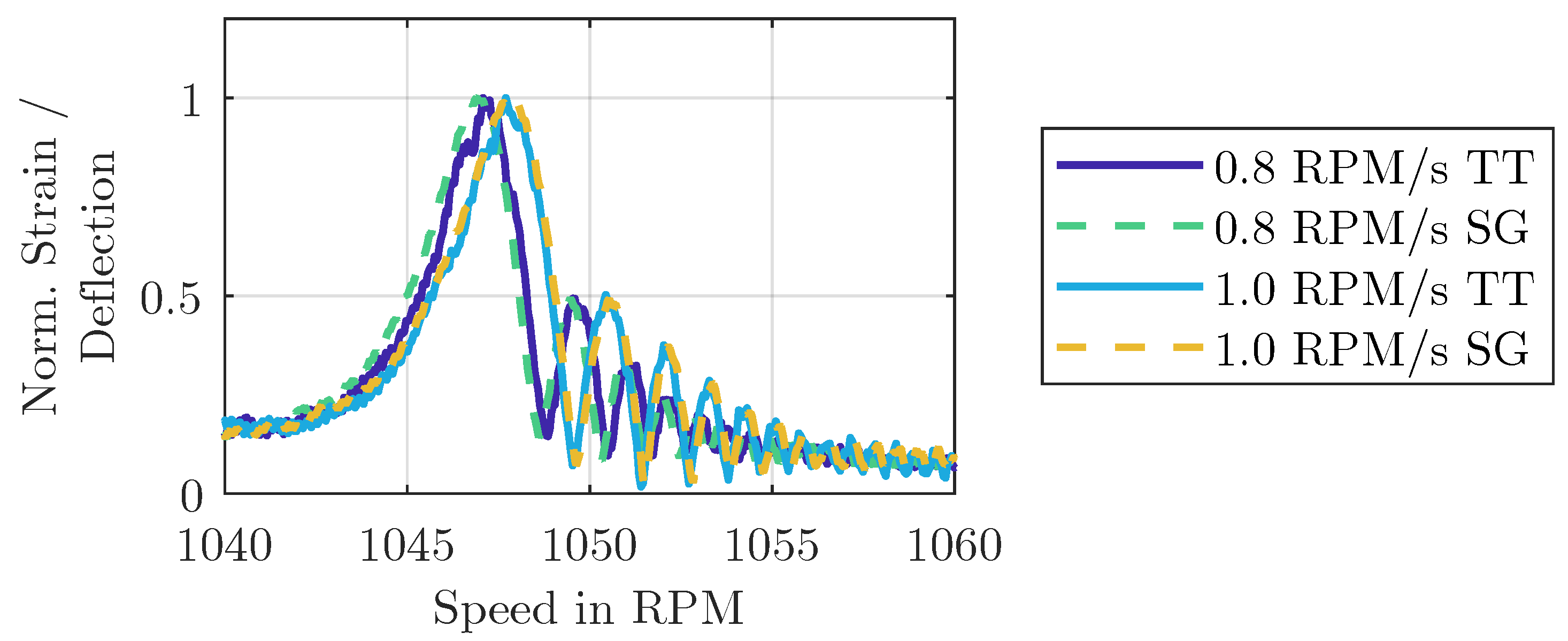


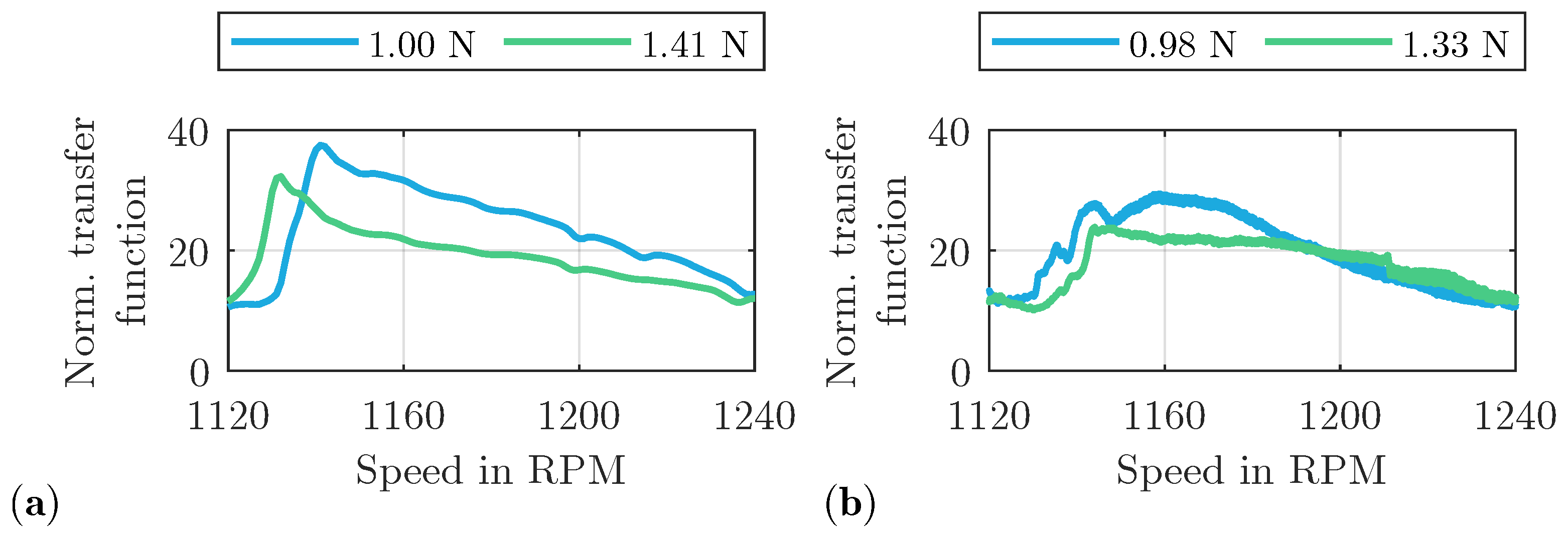
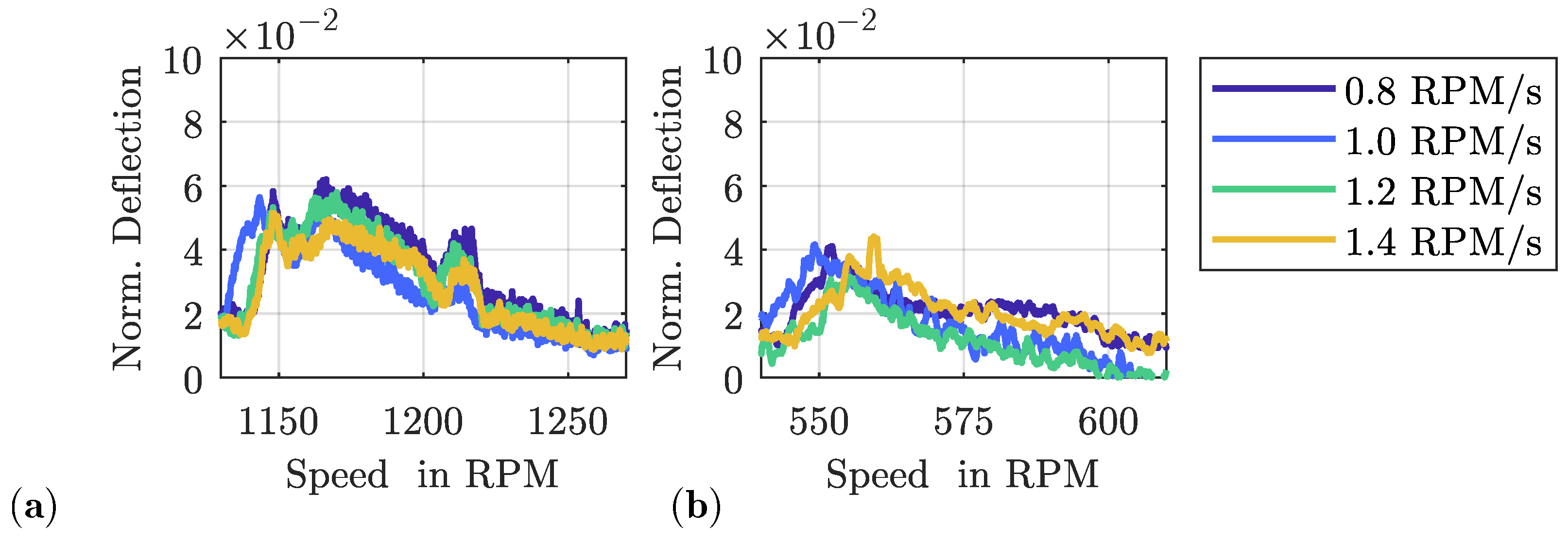
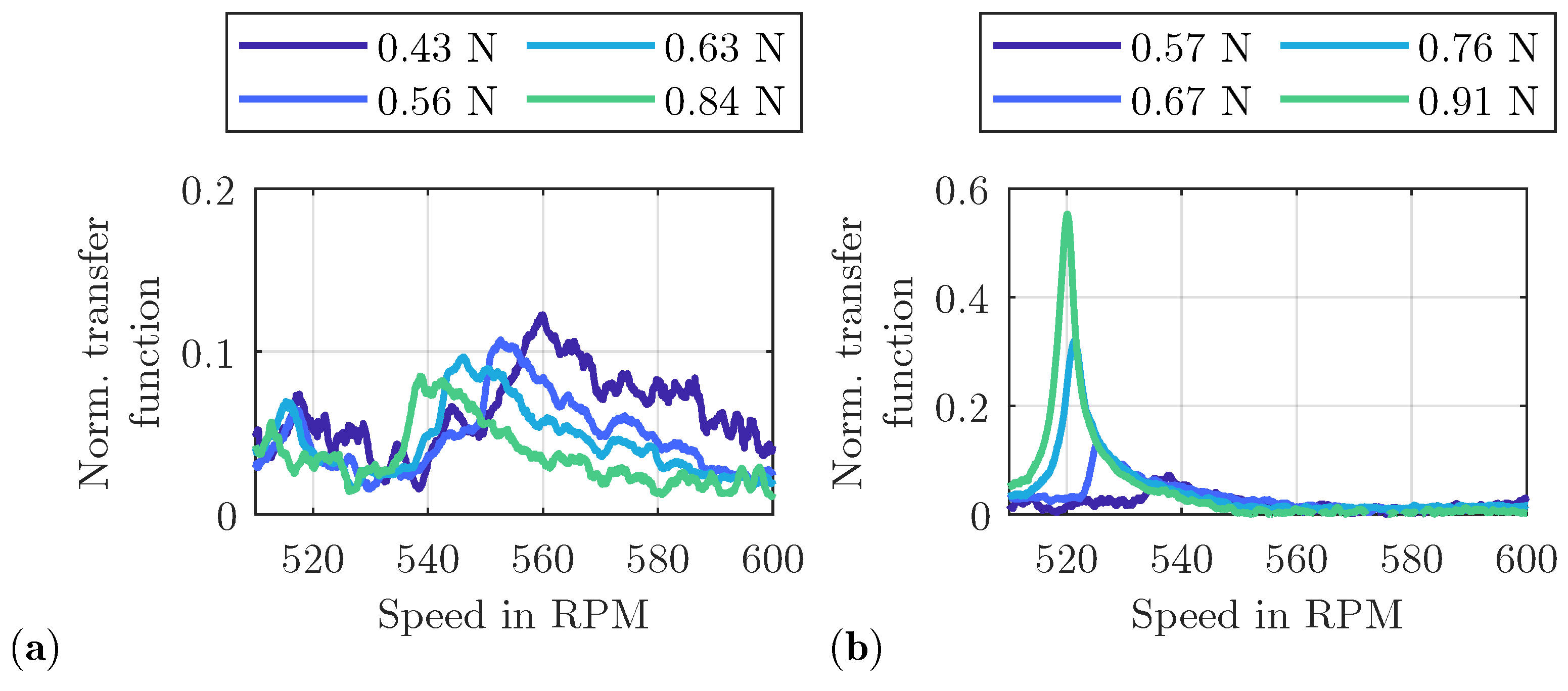


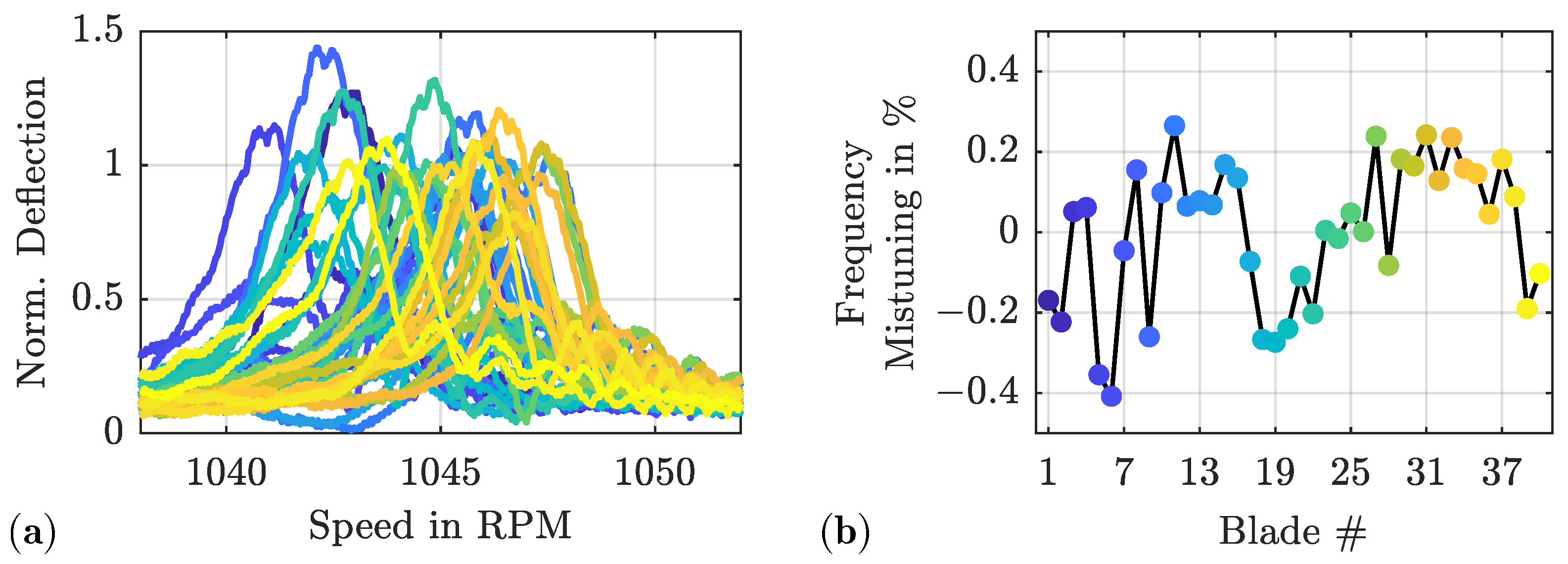
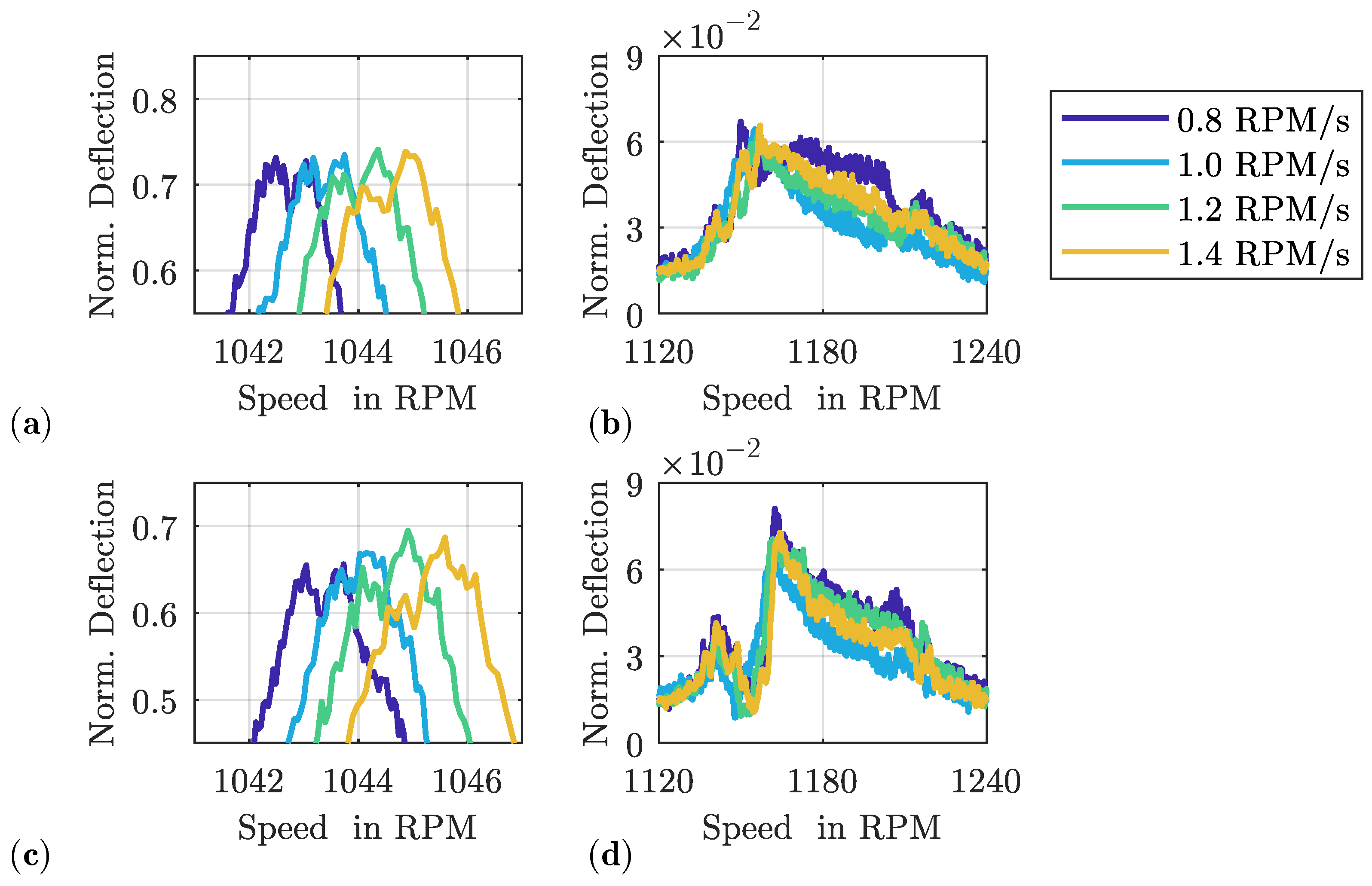
| Sweep Rate in | Reduced Sweep Rate | |
|---|---|---|
| EO 10 | EO 20 | |
Disclaimer/Publisher’s Note: The statements, opinions and data contained in all publications are solely those of the individual author(s) and contributor(s) and not of MDPI and/or the editor(s). MDPI and/or the editor(s) disclaim responsibility for any injury to people or property resulting from any ideas, methods, instructions or products referred to in the content. |
© 2023 by the authors. Licensee MDPI, Basel, Switzerland. This article is an open access article distributed under the terms and conditions of the Creative Commons Attribution (CC BY-NC-ND) license (https://creativecommons.org/licenses/by-nc-nd/4.0/).
Share and Cite
Brinkmann, K.; Hoffmann, T.; Panning-von Scheidt, L.; Stüer, H. Transient Resonance Passage of a Mistuned Bladed Disk with and without Underplatform Dampers. Int. J. Turbomach. Propuls. Power 2023, 8, 38. https://doi.org/10.3390/ijtpp8040038
Brinkmann K, Hoffmann T, Panning-von Scheidt L, Stüer H. Transient Resonance Passage of a Mistuned Bladed Disk with and without Underplatform Dampers. International Journal of Turbomachinery, Propulsion and Power. 2023; 8(4):38. https://doi.org/10.3390/ijtpp8040038
Chicago/Turabian StyleBrinkmann, Katharina, Thomas Hoffmann, Lars Panning-von Scheidt, and Heinrich Stüer. 2023. "Transient Resonance Passage of a Mistuned Bladed Disk with and without Underplatform Dampers" International Journal of Turbomachinery, Propulsion and Power 8, no. 4: 38. https://doi.org/10.3390/ijtpp8040038
APA StyleBrinkmann, K., Hoffmann, T., Panning-von Scheidt, L., & Stüer, H. (2023). Transient Resonance Passage of a Mistuned Bladed Disk with and without Underplatform Dampers. International Journal of Turbomachinery, Propulsion and Power, 8(4), 38. https://doi.org/10.3390/ijtpp8040038




